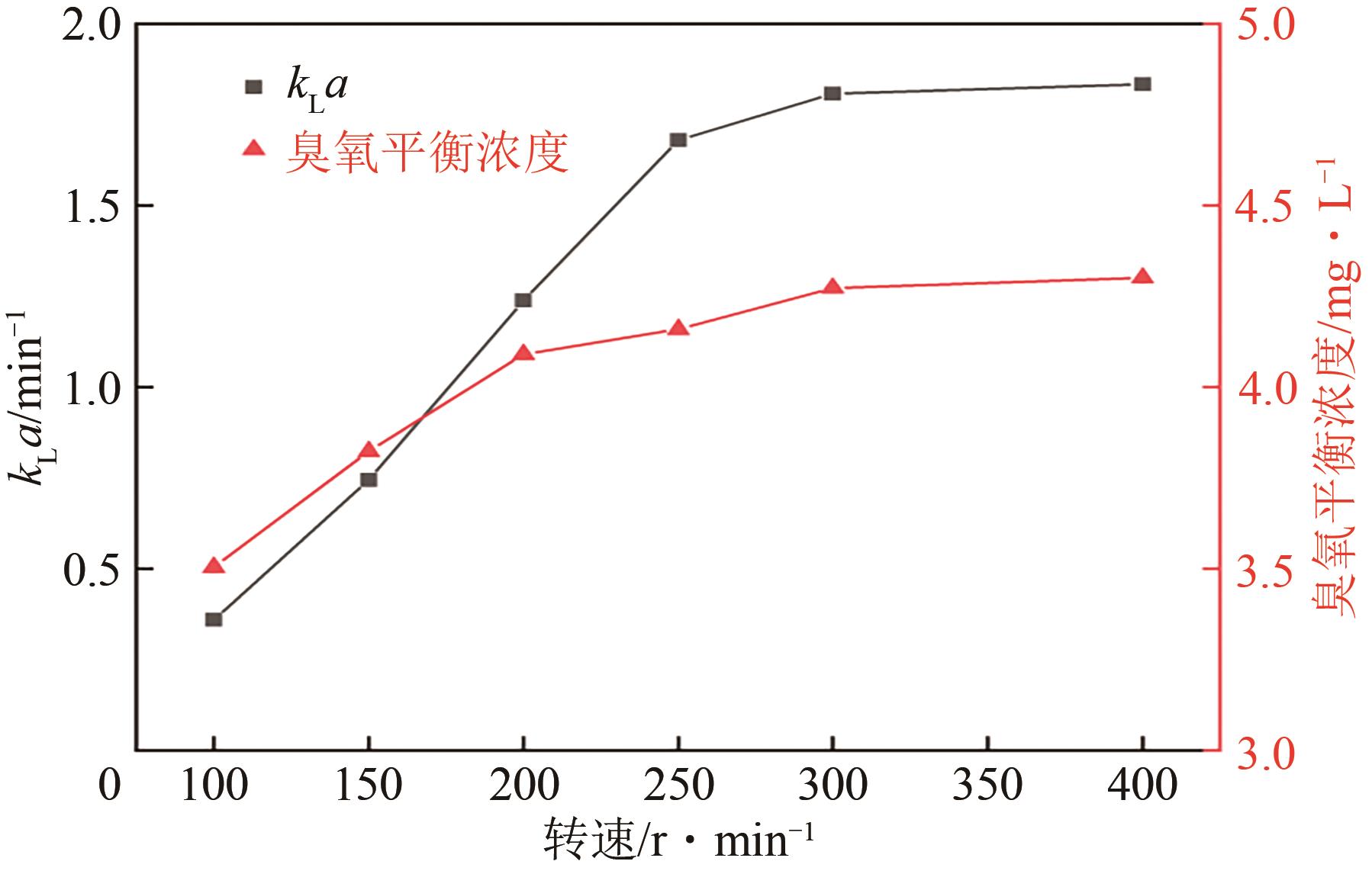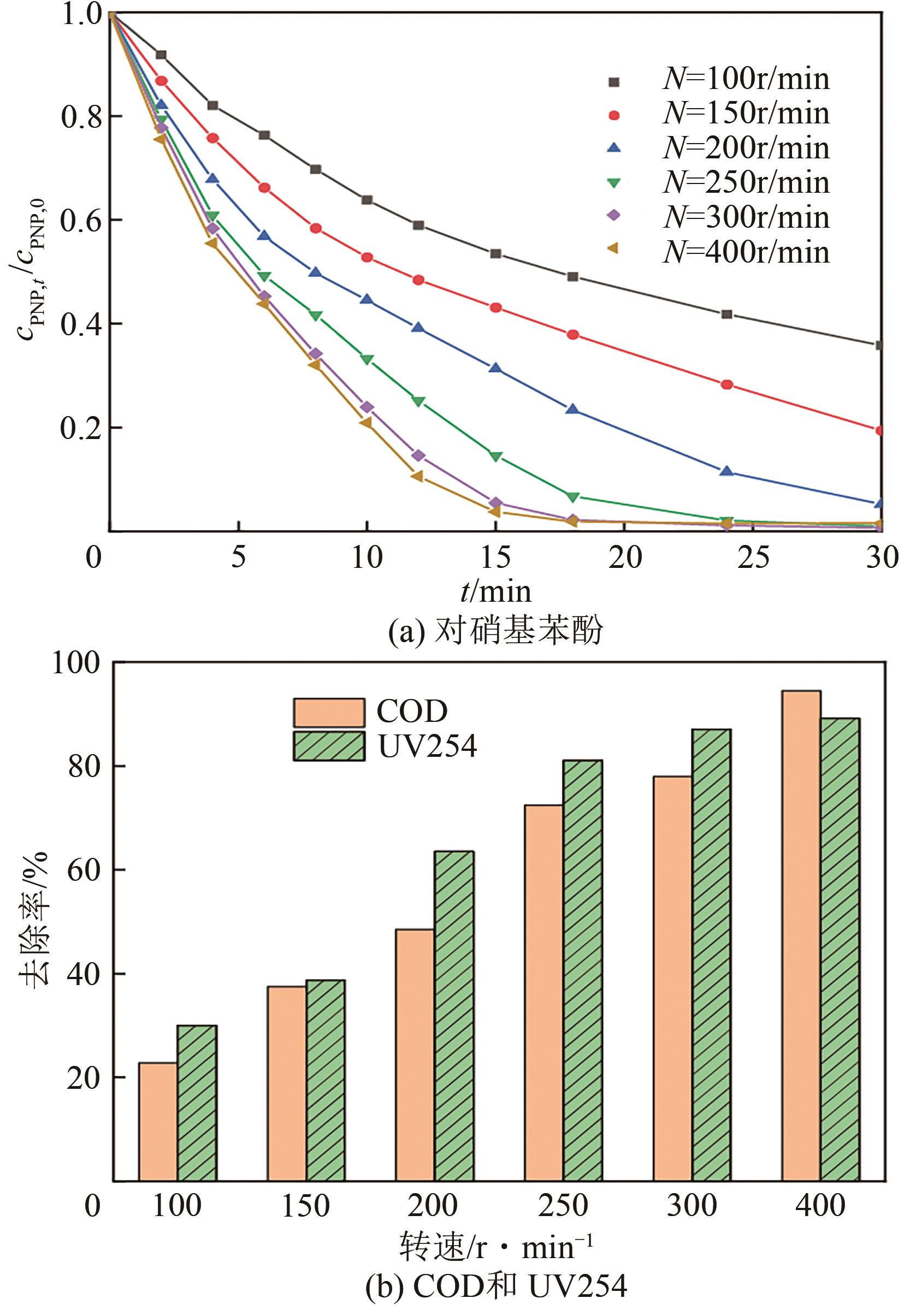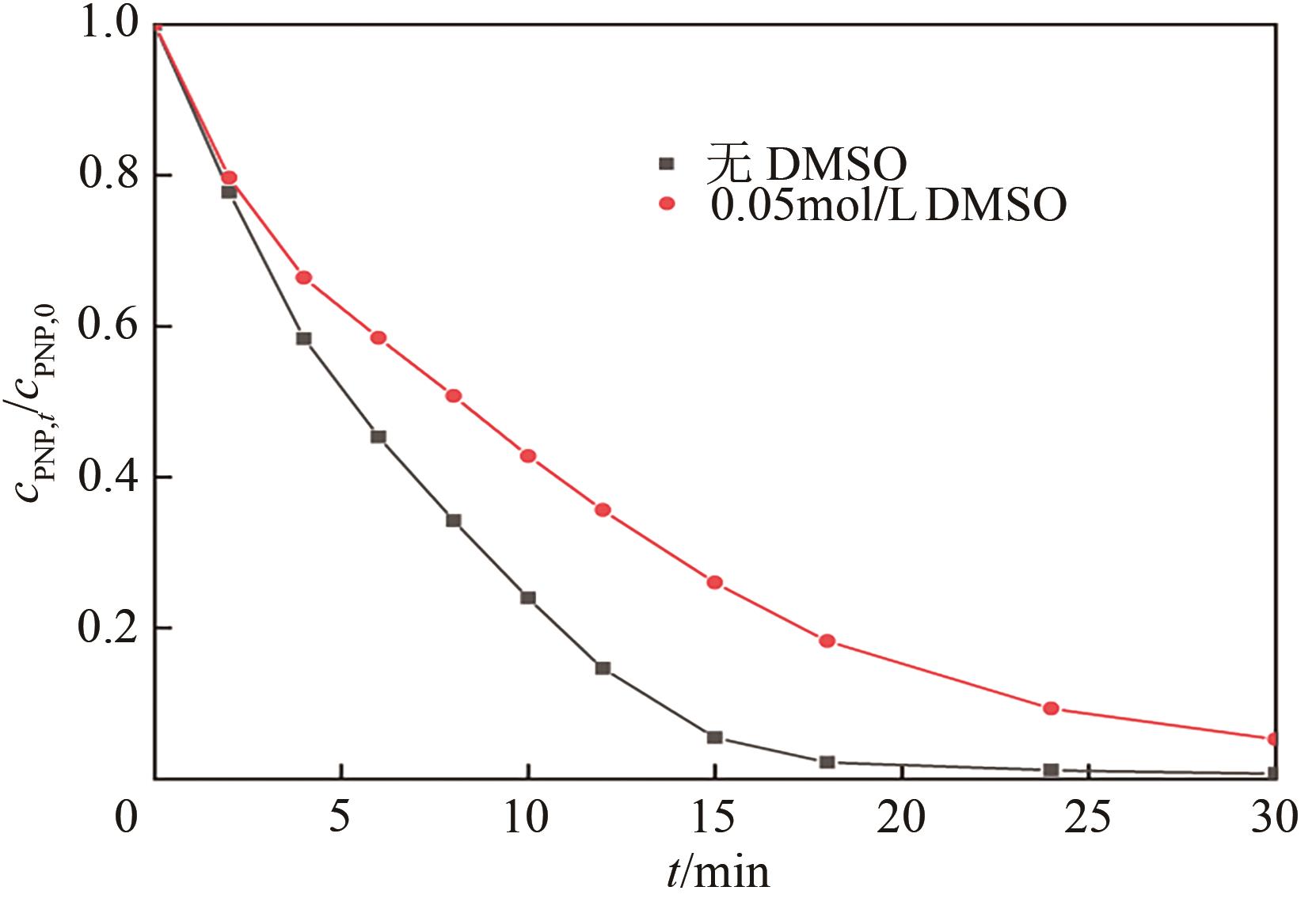化工进展 ›› 2021, Vol. 40 ›› Issue (7): 4091-4099.DOI: 10.16085/j.issn.1000-6613.2020-1704
旋转微气泡反应器强化臭氧降解水中对硝基苯酚
曾尚升( ), 杨宇成(
), 杨宇成( ), 张娜, 张学勤, 叶静, 黄雅燕, 肖美添
), 张娜, 张学勤, 叶静, 黄雅燕, 肖美添
- 华侨大学化工学院,福建 厦门 361021
-
收稿日期:2020-08-26修回日期:2020-11-15出版日期:2021-07-06发布日期:2021-07-19 -
通讯作者:杨宇成 -
作者简介:曾尚升(1994—),男,硕士研究生,研究方向为水污染治理。E-mail:18014087001@stu.hqu.edu.cn 。 -
基金资助:国家自然科学基金(21808071);华侨大学研究生科研创新能力培育计划;厦门市高校科研院所产学研项目(3502Z20193042)
Enhanced ozone degradation of the p-nitrophenol wastewater by rotating-microbubble reactor
ZENG Shangsheng( ), YANG Yucheng(
), YANG Yucheng( ), ZHANG Na, ZHANG Xueqin, YE Jing, HUANG Yayan, XIAO Meitian
), ZHANG Na, ZHANG Xueqin, YE Jing, HUANG Yayan, XIAO Meitian
- School of Chemical Engineering, Huaqiao University, Xiamen 361021, Fujian, China
-
Received:2020-08-26Revised:2020-11-15Online:2021-07-06Published:2021-07-19 -
Contact:YANG Yucheng
摘要:
臭氧氧化技术在水处理系统中具有良好的应用前景,但实际应用中受到臭氧传质及氧化选择性的限制。故本研究以对硝基苯酚废水为研究对象,采用一种新型旋转微气泡反应器,通过多孔陶瓷填料的旋转将臭氧气泡尺寸破碎至微米级别,实现对废水降解过程的强化,同时本研究还进一步考察了操作条件对臭氧传质过程和臭氧分解产生羟基自由基过程的影响规律。实验结果表明,提高反应器转速和气体流量可以加快臭氧传质和羟基自由基产率,同时提高溶液pH也可以提高羟基自由基产率进而提高对硝基苯酚的去除率。与其他操作变量相比,反应器转速的影响最为明显,说明改善臭氧气泡流体力学行为能有效地提高对硝基苯酚的去除效果,体现反应器强化臭氧体系的可行性。此外,二甲亚砜的加入抑制了对硝基苯酚的去除,说明臭氧的间接氧化方式是降解对硝基苯酚的一种重要途径。本研究结果为旋转微气泡反应器在臭氧氧化降解过程中开发及应用提供合理指导。
中图分类号:
引用本文
曾尚升, 杨宇成, 张娜, 张学勤, 叶静, 黄雅燕, 肖美添. 旋转微气泡反应器强化臭氧降解水中对硝基苯酚[J]. 化工进展, 2021, 40(7): 4091-4099.
ZENG Shangsheng, YANG Yucheng, ZHANG Na, ZHANG Xueqin, YE Jing, HUANG Yayan, XIAO Meitian. Enhanced ozone degradation of the p-nitrophenol wastewater by rotating-microbubble reactor[J]. Chemical Industry and Engineering Progress, 2021, 40(7): 4091-4099.
| 1 | OTURAN M A, PEIROTEN J, CHARTRIN P, et al. Complete destruction of p-nitrophenol in aqueous medium by electro-Fenton method[J]. Environmental Science & Technology, 2000, 34(16): 3474-3479. |
| 2 | 周文敏, 傅德黔, 孙宗光. 中国水中优先控制污染物黑名单的确定[J]. 环境科学研究, 1991, 4(6): 9-12. |
| ZHOU W M, FU D Q, SUN Z G. Determination of black list of China's priority pollutants in water[J]. Research of Environmental Sciences, 1991, 4(6): 9-12. | |
| 3 | ZHENG H, GUO Y, ZHU H, et al. p-Nitrophenol enhanced degradation in high-voltage pulsed corona discharges combined with ozone system[J]. Plasma Chemistry & Plasma Processing, 2013, 33(6): 1053-1062. |
| 4 | LIN S H, WANG C H. Ozonation of phenolic wastewater in a gas-induced reactor with a fixed granular activated carbon bed[J]. Industrial & Engineering Chemistry Research, 2003, 42(8): 1648-1653. |
| 5 | QI Y N. Ozonation of water and waste water: a practical guide to understanding ozone and its applications[J]. International Journal of Environmental Studies, 2010, 67(5): 795-796. |
| 6 | LIU T R, WANG D, WANG W, et al. Study on the efficient production of ozone water by a rotating packed bed[J]. Industrial & Engineering Chemistry Research, 2019, 58(17): 7227-7232. |
| 7 | WANG B, XIONG X, SHUI Y Y, et al. A systematic study of enhanced ozone mass transfer for ultrasonic-assisted PTFE hollow fiber membrane aeration process[J]. Chemical Engineering Journal, 2019, 357: 678-688. |
| 8 | BEGUM A, GAUTAM S K. Endosulfan and lindane degradation using ozonation[J]. Environmental Technology, 2012, 33(8): 943-949. |
| 9 | SHIN W T, MIRMIRAN A, YIACOUMI S, et al. Ozonation using microbubbles formed by electric fields[J] . Separation and Purification Technology, 1999, 15(3): 271-282. |
| 10 | HOIGNE J, BADER H, HAAG W R, et al. Rate constants of reactions of ozone with organic and inorganic compounds in water—Ⅲ. Inorganic compounds and radicals[J]. Water Research, 1985, 19(8): 993-1004. |
| 11 | ZHU S M, DONG B Z, YU Y H, et al. Heterogeneous catalysis of ozone using ordered mesoporous Fe3O4 for degradation of atrazine[J]. Chemical Engineering Journal, 2017, 328: 527-535. |
| 12 | CHU L B, XING X H, YU A F, et al. Enhanced ozonation of simulated dyestuff wastewater by microbubbles[J]. Chemosphere, 2007, 68(10): 1854-1860. |
| 13 | TAKAHSHI M, HORIBE H, MATSUURA K, et al. Effect of microbubbles on ozonized water for photoresist removal[J]. Journal of Photopolymer Science and Technology, 2015, 28(2): 293-298. |
| 14 | 杨宇成, 杨时颖, MOSES Arowo. 旋转泡沫填料反应器的研究进展[J]. 化工进展, 2018, 37(6): 21-27. |
| YANG Y C, YANG S Y, MOSES Arowo. Research progress in a rotating foam reactor[J]. Chemical Industry and Engineering Progress, 2018, 37(6): 2046-2052. | |
| 15 | TSCHENTSCHER R, NIJHUIS T A, SCHAAF J VAN DER, et al. Glucose oxidation in slurry reactors and rotating foam reactors[J]. Industrial & Engineering Chemistry Research, 2012, 51(4): 1620-1634. |
| 16 | LALI F, BÖTTCHER G, SCHÖNEICH P M, et al. Preparation and characterization of Pd/Al2O3 catalysts on aluminum foam supports for multiphase hydrogenation reactions in rotating foam reactors[J]. Chemical Engineering Research and Design: Transactions of the Institution of Chemical Engineers, 2015, 94: 365-374. |
| 17 | YANG Y C, YU X H, YU Q J, et al. Micromixing efficiency in a multiphase reactor with a foam block stirrer[J]. The Canadian Journal of Chemical Engineering, 2019, 97: 1560-1567. |
| 18 | YANG Y C, OUYANG Y, YU X H, et al. Micromixing efficiency in a rotating foam stirrer reactor with various reactor configurations and liquid viscosities[J]. Journal of Chemical Technology & Biotechnology, 2019, 94(8): 2651-2660. |
| 19 | TSCHENTSCHER R, SPIJKERS R J P, NIJHUIS T A, et al. Liquid-solid mass transfer in agitated slurry reactors and rotating solid foam reactors[J]. Industrial & Engineering Chemistry Research, 2010, 49(21): 10758-10766. |
| 20 | BADER H, HOIGNE J. Determination of ozone in water by the indigo method[J]. Water Research, 1981, 15(4): 449-456. |
| 21 | KUKUZAKI M, FUJIMOTO K, KAI S, et al. Ozone mass transfer in an ozone-water contacting process with Shirasu porous glass (SPG) membranes—A comparative study of hydrophilic and hydrophobic membranes[J]. Separation & Purification Technology, 2010, 72(3): 347-356. |
| 22 | BIN A K. Ozone dissolution in aqueous systems treatment of the experimental data[J]. Experimental Thermal & Fluid Science, 2004, 28(5): 395-405. |
| 23 | FLYUNT R, LEITZKE A, MARK G, et al. Determination of ·OH, O2-·, and hydroperoxide yields in ozone reactions in aqueous solution[J]. The Journal of Physical Chemistry B, 2003, 107(30): 7242-7253. |
| 24 | 李哲. 类Fenton反应中羟基自由基生成的化学发光动力学研究及其在灭菌和染料降解中的应用[D]. 北京: 北京化工大学, 2019. |
| LI Z. Chemiluminescence kinetic study on the generation of hydroxyl radicals in Fenton-like reaction and its application in sterilization and dye degradation processes[D]. Beijing: Beijing University of Chemical Technology, 2019. | |
| 25 | 沈慧芳. 几种有机物臭氧化或复合氧化的动力学和传质研究[D]. 广州: 华南理工大学, 2002. |
| SHEN H F. Kineties and mass transfer studies of oxidaton of organic compounds in solutions containing ozone with or without hydrogen peroxide[D]. Guangzhou: South China University of Technology, 2002. | |
| 26 | HWANG B K, SON H S, KIM J H, et al. Decomposition of excess sludge in a membrane bioreactor using a turbulent jet flow ozone contactor[J]. Journal of Industrial & Engineering Chemistry, 2010, 16(4): 602-608. |
| 27 | TIAN X, WANG C, TRZCINSKI A P, et al. Interpreting the synergistic effect in combined ultrasonication-ozonation sewage sludge pre-treatment[J]. Chemosphere, 2015, 140: 63-71. |
| 28 | 倪丽, 郭晓滨, 金菁. 絮凝沉淀-臭氧氧化法处理DDNP生产废水[J]. 科技信息, 2009(4): 398-399. |
| NI L, GUO X B, JIN J. Flocculation sedimentation-ozone oxidation method to treat DDNP production wastewater[J]. Science & Technology Information, 2009(4): 398-399. | |
| 29 | GAO MT, HIRATA M, TAKANASHI H, et al. Ozone mass transfer in a new gas-liquid contactor-Karman contactor[J]. Separation and Purification Technology, 2005, 42(2): 145-149. |
| 30 | KUOSA M, KALLAS J, HAKKINEN A. Ozonation of p-nitrophenol at different pH values of water and the influence of radicals at acidic conditions[J]. Journal of Environmental Chemical Engineering, 2015, 3(1): 325-332. |
| 31 | LIN S H, WANG C H. Industrial wastewater treatment in a new gas-induced ozone reactor[J]. Journal of Hazardous Materials, 2003, 98(1/2/3): 295-309. |
| 32 | 刘亚坤. 金属氧化物催化臭氧氧化对硝基苯酚的研究[D]. 武汉: 武汉理工大学, 2012. |
| LIU Y K. Catalytic ozonation of p-nitrophenol by metal oxides[D]. Wuhan: WuhanUniversity of Technology, 2012. | |
| 33 | MA J, SUI M H, ZHANG T, et al. Effect of pH on MnOx/GAC catalyzed ozonation for degradation of nitrobenzene[J]. Water Research, 2005, 39(5): 779-786. |
| 34 | GAO M P, ZENG Z Q, SUN B C, et al. Ozonation of azo dye Acid Red 14 in a microporous tube-in-tube microchannel reactor: decolorization and mechanism[J]. Chemosphere, 2012, 89(2): 190-197. |
| 35 | HE Z Q, LIN L L, SONG S, et al. Mineralization of C.I. reactive Blue 19 by ozonation combined with sonolysis: performance optimization and degradation mechanism[J]. Separation & Purification Technology, 2008, 62(2): 376-381. |
| 36 | KHALIL T T, BAZZI R, ROUX S, et al. The contribution of hydrogen peroxide to the radiosensitizing effect of gold nanoparticles[J]. Colloids & Surfaces B: Biointerfaces, 2019, 175: 606-613. |
| 37 | BUXTON G V, GREENSTOCK C L, HELMAN W P, et al. Critical review of rate constants for reactions of hydrated electrons, hydrogen atoms and hydroxyl radicals (·OH/·O-) in aqueous solution[J]. Journal of Physical and Chemical Reference Data, 1988, 17(2): 513-886. |
| [1] | 盛维武, 程永攀, 陈强, 李小婷, 魏嘉, 李琳鸽, 陈险峰. 微气泡和微液滴双强化脱硫反应器操作分析[J]. 化工进展, 2023, 42(S1): 142-147. |
| [2] | 黄益平, 李婷, 郑龙云, 戚傲, 陈政霖, 史天昊, 张新宇, 郭凯, 胡猛, 倪泽雨, 刘辉, 夏苗, 主凯, 刘春江. 三级环流反应器中气液流动与传质规律[J]. 化工进展, 2023, 42(S1): 175-188. |
| [3] | 杨寒月, 孔令真, 陈家庆, 孙欢, 宋家恺, 王思诚, 孔标. 微气泡型下向流管式气液接触器脱碳性能[J]. 化工进展, 2023, 42(S1): 197-204. |
| [4] | 陈匡胤, 李蕊兰, 童杨, 沈建华. 质子交换膜燃料电池气体扩散层结构与设计研究进展[J]. 化工进展, 2023, 42(S1): 246-259. |
| [5] | 许家珩, 李永胜, 罗春欢, 苏庆泉. 甲醇水蒸气重整工艺的优化[J]. 化工进展, 2023, 42(S1): 41-46. |
| [6] | 高雨飞, 鲁金凤. 非均相催化臭氧氧化作用机理研究进展[J]. 化工进展, 2023, 42(S1): 430-438. |
| [7] | 许春树, 姚庆达, 梁永贤, 周华龙. 共价有机框架材料功能化策略及其对Hg(Ⅱ)和Cr(Ⅵ)的吸附性能研究进展[J]. 化工进展, 2023, 42(S1): 461-478. |
| [8] | 赵景超, 谭明. 表面活性剂对电渗析减量化工业含盐废水的影响[J]. 化工进展, 2023, 42(S1): 529-535. |
| [9] | 邵博识, 谭宏博. 锯齿波纹板对挥发性有机物低温脱除过程强化模拟分析[J]. 化工进展, 2023, 42(S1): 84-93. |
| [10] | 刘炫麟, 王驿凯, 戴苏洲, 殷勇高. 热泵中氨基甲酸铵分解反应特性及反应器结构优化[J]. 化工进展, 2023, 42(9): 4522-4530. |
| [11] | 罗成, 范晓勇, 朱永红, 田丰, 崔楼伟, 杜崇鹏, 王飞利, 李冬, 郑化安. 中低温煤焦油加氢反应器不同分配器中液体分布的CFD模拟[J]. 化工进展, 2023, 42(9): 4538-4549. |
| [12] | 程涛, 崔瑞利, 宋俊男, 张天琪, 张耘赫, 梁世杰, 朴实. 渣油加氢装置杂质沉积规律与压降升高机理分析[J]. 化工进展, 2023, 42(9): 4616-4627. |
| [13] | 王晨, 白浩良, 康雪. 大功率UV-LED散热与纳米TiO2光催化酸性红26耦合系统性能[J]. 化工进展, 2023, 42(9): 4905-4916. |
| [14] | 王琦, 寇丽红, 王冠宇, 王吉坤, 刘敏, 李兰廷, 王昊. 焦化废水生物出水中可溶解性有机物的分子识别[J]. 化工进展, 2023, 42(9): 4984-4993. |
| [15] | 史天茜, 石永辉, 武新颖, 张益豪, 秦哲, 赵春霞, 路达. Fe2+对厌氧氨氧化EGSB反应器运行性能的影响[J]. 化工进展, 2023, 42(9): 5003-5010. |
| 阅读次数 | ||||||
|
全文 |
|
|||||
|
摘要 |
|
|||||












